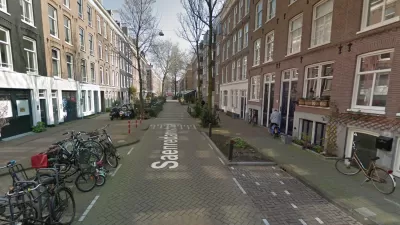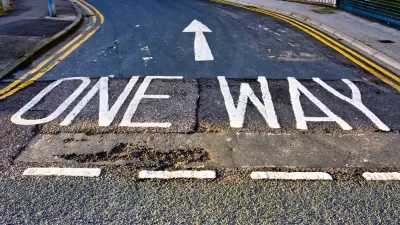One justification for municipal minimum parking requirements is the danger of “spillover parking”: the fear that if Big Brother does not force businesses to build huge parking lots, that business’s customers will “spill over” into neighboring businesses or residential neighborhoods, thus reducing the parking available to the latter group. For example, if Wal-Mart doesn’t build a thousand parking spaces, maybe Wal-Mart’s customers will park at Mom’n’Pop Groceries down the street, thus reducing the parking available to Mom’n’Pop customers.
One justification for municipal minimum
parking requirements is the danger of "spillover parking": the fear that if Big
Brother does not force businesses to build huge parking lots, that business's
customers will "spill over" into neighboring businesses or residential
neighborhoods, thus reducing the parking available to the latter group. For example, if Wal-Mart doesn't build a
thousand parking spaces, maybe Wal-Mart's customers will park at Mom'n'Pop Groceries
down the street, thus reducing the parking available to Mom'n'Pop customers.
I recently noticed one flaw in this argument: spillover
parking may be as likely to create positive externalities [that is, benefits to
persons not party to a transaction] as negative externalities. For example, yesterday I needed to go to both
the library and a bank. The library is a
five minute walk from the bank, yet both have their own parking spaces. As a result, I had to drive to the library, then
drive separately to the bank, thus creating an extra car trip and creating a
tiny bit of pollution and congestion on the street between the two
buildings.
By contrast, if I had just parked at the library and then walked
to and from the bank, I would have been committing the sin of spillover
parking: parking at building A while doing errands at building B. Yet I would have actually created positive
externalities: by walking from the library to the bank, I would have reduced
the amount of vehicle trips in the neighborhood, thus making life slightly
easier for other drivers, and making the neighborhood air a tiny bit
cleaner. On the other hand, I would have
created negative externalities only if my car had been the last car to park at
the library or bank, thus inconveniencing customers of one of those businesses.
Conversely, the parking requirements designed to prevent
spillover parking have negative externalities as well as positive ones. Such regulations prevent the inconveniences
that may result from spillover parking- but they also subsidize driving by forcing
every business to build parking lots, thus creating an artificial glut of
parking, thus driving the market price of parking down to zero, thus creating
additional driving, thus creating additional pollution and congestion. And because these regulations encourage
businesses to set their buildings back behind a wall of parking, they create an
urban atmosphere that is not tremendously welcoming for pedestrians. Where shops are far from the street,
pedestrians have longer commutes to their destinations, and those commutes are
more dangerous as well because they must dodge vehicles on the way to shops and
apartments.
In sum, the externalities caused by spillover parking may be
as likely to be helpful as harmful- while the regulations designed to prevent
such parking actually create harmful externalities.

Study: Maui’s Plan to Convert Vacation Rentals to Long-Term Housing Could Cause Nearly $1 Billion Economic Loss
The plan would reduce visitor accommodation by 25,% resulting in 1,900 jobs lost.

Alabama: Trump Terminates Settlements for Black Communities Harmed By Raw Sewage
Trump deemed the landmark civil rights agreement “illegal DEI and environmental justice policy.”

Why Should We Subsidize Public Transportation?
Many public transit agencies face financial stress due to rising costs, declining fare revenue, and declining subsidies. Transit advocates must provide a strong business case for increasing public transit funding.

Paris Bike Boom Leads to Steep Drop in Air Pollution
The French city’s air quality has improved dramatically in the past 20 years, coinciding with a growth in cycling.

Why Housing Costs More to Build in California Than in Texas
Hard costs like labor and materials combined with ‘soft’ costs such as permitting make building in the San Francisco Bay Area almost three times as costly as in Texas cities.

San Diego County Sees a Rise in Urban Coyotes
San Diego County experiences a rise in urban coyotes, as sightings become prevalent throughout its urban neighbourhoods and surrounding areas.
Urban Design for Planners 1: Software Tools
This six-course series explores essential urban design concepts using open source software and equips planners with the tools they need to participate fully in the urban design process.
Planning for Universal Design
Learn the tools for implementing Universal Design in planning regulations.
Smith Gee Studio
Alamo Area Metropolitan Planning Organization
City of Santa Clarita
Institute for Housing and Urban Development Studies (IHS)
City of Grandview
Harvard GSD Executive Education
Toledo-Lucas County Plan Commissions
Salt Lake City
NYU Wagner Graduate School of Public Service





























